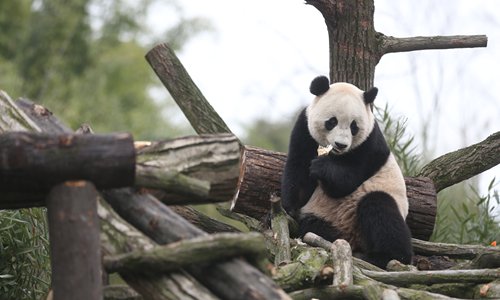
The U.S.-born giant panda Baobao makes its official Chinese debut in Dujiangyan, Sichuan Province. (Photo: Cui Meng/GT)
Responses
The enthusiasts raised these concerns on the GCF's Facebook page months ago, but they found that their comments were deleted, which added to their suspicions about the program and the fate of the first released panda pair.
On March 27, the GCF issued two statements, saying that their work is an "arduous task," their team has acted "in a careful and professional manner" and "the panda cubs are safe and well cared for."
"Occasionally we become the target of slander, abuse and baseless criticism. It seems to be part of the world we live in. We're trying to learn to ignore it," it said in one statement.
At that time the GCF made no mention of the cubs.
Two days later, the Chengdu base issued a statement revealing that on September 27, 2016 they launched a search after receiving an alarm signal from Hesheng's GPS collar, and found his carcass the next day. Their autopsy showed that he died of infections caused by injuries inflicted by unknown animals. Qianqian is apparently still healthy in the wild.
The base also clarified that training and tests were carried out methodically before the pair were released and that every step was carried out based on scientific assessments.
"Normally speaking, the success rate of introducing captive-born animals into the wild is very low," the base said.
It also explained that "as the research is in the preliminary exploration stage, it is inappropriate for the base to disclose information concerning the reintroduction project."
In late 2011, the Chengdu base announced its plan to release animals into the wild. Base director Zhang Zhihe declared that they will eventually release about 30 to 40 pandas into the wild after the completion of Panda Valley, a transitional zone covering 134 hectares.
On January 11, 2012, a grand ceremony was held at the valley as it became home to its first residents, six cubs aged between 2 and 4 years old. Retired Chinese basketball star and wildlife activist Yao Ming was on hand to open the bears' cages. In November that year, a panda mother and her 1-year-old daughter moved in, the Xinhua News Agency reported.
But the subsequent scarcity of official updates about the pandas raised skepticism among some panda watchers, concerns which were only heightened after the release of Hesheng and Qianqian.
Global Times interview requests to the Chengdu base remained unanswered as press time. A worker from the director's office said that "the State Forestry Administration issued an interview ban due to its sensitivity."
The GCF and Benjamin Kilham declined interview requests also, saying that they have been asked to refer all questions on this topic to the Chengdu base.
Ultimate outlet
Robert said the Chengdu base failed to dismiss their doubts. "Why not follow the Wolong base's reintroduction method that experts have researched for years and come to the conclusion that there shouldn't be any direct human interaction with the pandas?" he questioned.
Population surveys have found that the number of giant pandas in the wild is on the rise and totals about 2,000. But the number of panda groups has decreased due to damage to their natural habitat.
These fragmented habitats hinder gene transmission and population diversity, bringing long-term risks to the species, according to a China Pictorial report in October last year.
To enhance population viability, the China Conservation and Research Center for the Giant Panda in Wolong, Sichuan, first launched its re-wilding research in 2001.
In April 2006, it released Xiangxiang, a 5-year-old male, into the wild, but found his carcass nine months later. He died from injuries sustained in a fall after getting into a fight with wild-born males.
Wu Daifu who directs the Wolong center's reintroduction project recently told the Beijing News that they have learned the lessons of this incident and improved their methods. Xiangxiang was trained for release from adolescence onwards and had gotten used to depending on humans. The center has now started to train bears from birth with their mother and have tried to minimize human contact by wearing panda costumes stained with panda excrement and urine when they go near the bears.
The State Forestry Administration announced that the Wolong center has so far released seven cubs into the wild and five are still alive.
Hu Jinchu, an 88-year-old giant panda expert, told the Global Times that it's too early to judge the merits of the two methods. "Panda reintroduction is still at the trial stage. It is a systematic and long-term procedure, needs multi-disciplinary efforts and faces huge difficulties," he said. "It's nearly impossible to ensure a 100 percent survival rate now. There is a price to pay for any scientific exploration."
In addition, the success of the releases are judged based on many factors, including whether the cubs survive, mate and breed, and whether their offspring survive, Hu noted.
He argued that releasing pandas is more challenging than releasing black bears. "Black bears are omnivorous. But pandas solely live on bamboo in the wild, and the edible parts differ in different seasons," Hu said.
But he believed that both institutions should look to cooperate with each other. They should break boundaries and introduce multidisciplinary efforts.
"Reintroduction is just a way to increase population sizes and genetic diversity, rather than an ultimate path to protecting the creature. The most important thing is to protect their habitat," Hu stressed.
The country has decided to address this issue. The government announced recently that it plans to build a huge Giant Panda National Park spanning three provinces to help the endangered animals mingle and enrich their gene pool.


















































